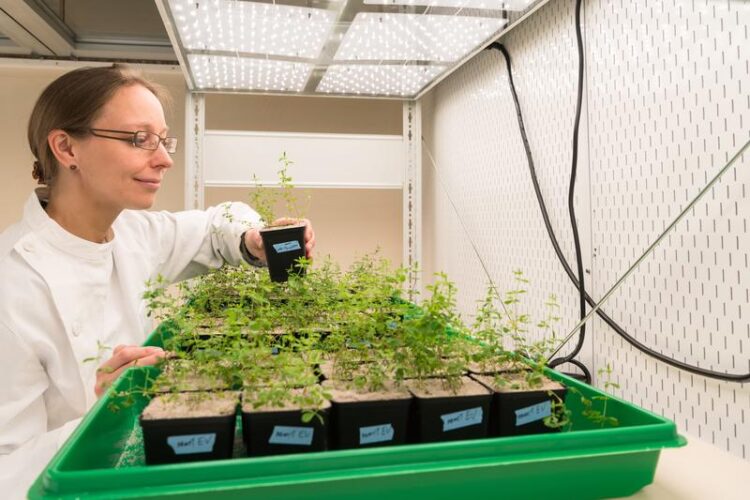A molecular break for root growth

Prof. Dr. Caroline Gutjahr in the laboratory during the experiments in the climate chamber.
(c) U. Benz / TUM
The dynamic change in root growth of plants plays an important role in their adjustment to soil conditions. Depending on the location, nutrients or moisture can be found in higher or lower soil layers. This is why, depending on the situation, a short or a long root is advantageous. Caroline Gutjahr, Professor of Plant Genetics at the Technical University of Munich (TUM), and her team investigate how plant hormones influence the growth of roots.
Roots are essential for reaching water and nutrients, for anchorage to the ground, but also for interacting and communicating with microorganisms in the soil. A long root enables the plant to reach deeper, more humid layers of soil, for example during drought. A shallower root with many root hairs is good for phosphate uptake, as phosphate is mostly found in the upper soil layers.
Caroline Gutjahr, Professor of Plant Genetics at the TUM School of Life Sciences in Weihenstephan, and her team discovered new hormone interactions which influence the growth of plant roots.
Why some plant roots have long and others have short hairs
“We found that the protein SMAX1 acts as molecular break for ethylene production”, says Caroline Gutjahr. Ethylene is a plant hormone that is considered to trigger or accelerate the ripening of many fruits and vegetables, but it can also trigger other processes in plants. If less of the gaseous hormone is produced by the plant, the plant is stimulated to grow long roots and short root hairs.
The suppressor “SMAX1” can be removed by activating the so-called karrikin signaling pathway, which is triggered by another hormone. This switches on the production of ethylene, resulting in short primary roots and elongated root hairs.
This is the first time that scientists have succeeded in identifying and understanding a molecular process that is switched on by the karrikin signaling pathway and in showing a molecular mechanism, by which this signaling pathway regulates a developmental process in plants.
Plant diversity is also reflected in molecular mechanisms
“Surprisingly this mechanism has a significant impact on the roots of the legume Lotus japonicus, the model plant for peas, beans and lentils, on which we conducted our research,” says Gutjahr.
In contrast, the research team observed a much weaker influence in the roots of another model plant, Arabidopsis thaliana or thale cress, which is related to cabbage plants.
“This shows that the diversity of plants is not only reflected in their appearance, but also in the effect of their molecular triggers on growth,” the researcher concludes.
The relevance of improving root growth for plant breeding
“If we understand more precisely how root growth is regulated at the molecular level and in coordination with environmental stimuli, we can cultivate crops that are better able to cope with unfavorable environmental conditions and thus produce yield even under stress,” explains the scientist.
This is why her research group is now investigating how the identified hormone signaling pathways (karrikin and ethylene signaling) react to different environmental conditions. They hope to discover how these two signaling pathways collaborate with the sensors that allow plants to perceive various environmental influences to adjust root growth to benefit plant survival and yield.
Wissenschaftliche Ansprechpartner:
Prof. Dr. Caroline Gutjahr
Assistant Professorship of Plant Genetics
TUM School of Life Sciences Weihenstephan
Technical University of Munich
Email: caroline.gutjahr(at)tum.de
https://www.genetik.wzw.tum.de/
Originalpublikation:
Carbonnel, S., Das, D., Varshney, K., Kolodziej, M.C., Villaécija-Aguilar, J.A., Gutjahr, C. (2020): The karrikin signaling regulator SMAX1 controls Lotus japonicus root and root hair development by suppressing ethylene biosynthesis. In: PNAS, 117: 21757-21765.
https://www.pnas.org/content/117/35/21757
Weitere Informationen:
https://www.professoren.tum.de/en/gutjahr-caroline (The work on which this publication is based was funded by the German Research Foundation (DFG) within the Emmy Noether Program (AG Gutjahr). A co-author (Kartikye Varshney) has also received a DAAD scholarship for doctoral students.)
https://mediatum.ub.tum.de/1576953 (High resolution images)
https://www.tum.de/nc/en/about-tum/news/press-releases/details/36257/ (Press release)h the copyright noted.
Media Contact
All latest news from the category: Machine Engineering
Machine engineering is one of Germany’s key industries. The importance of this segment has led to the creation of new university degree programs in fields such as production and logistics, process engineering, vehicle/automotive engineering, production engineering and aerospace engineering among others.
innovations-report offers informative reports and articles covering technologies such as automation, motion, power train, energy, conveyor, plastics, lightweight construction, logistics/warehousing, measurement systems, machine tools and control engineering.
Newest articles

Bringing bio-inspired robots to life
Nebraska researcher Eric Markvicka gets NSF CAREER Award to pursue manufacture of novel materials for soft robotics and stretchable electronics. Engineers are increasingly eager to develop robots that mimic the…

Bella moths use poison to attract mates
Scientists are closer to finding out how. Pyrrolizidine alkaloids are as bitter and toxic as they are hard to pronounce. They’re produced by several different types of plants and are…

AI tool creates ‘synthetic’ images of cells
…for enhanced microscopy analysis. Observing individual cells through microscopes can reveal a range of important cell biological phenomena that frequently play a role in human diseases, but the process of…





















